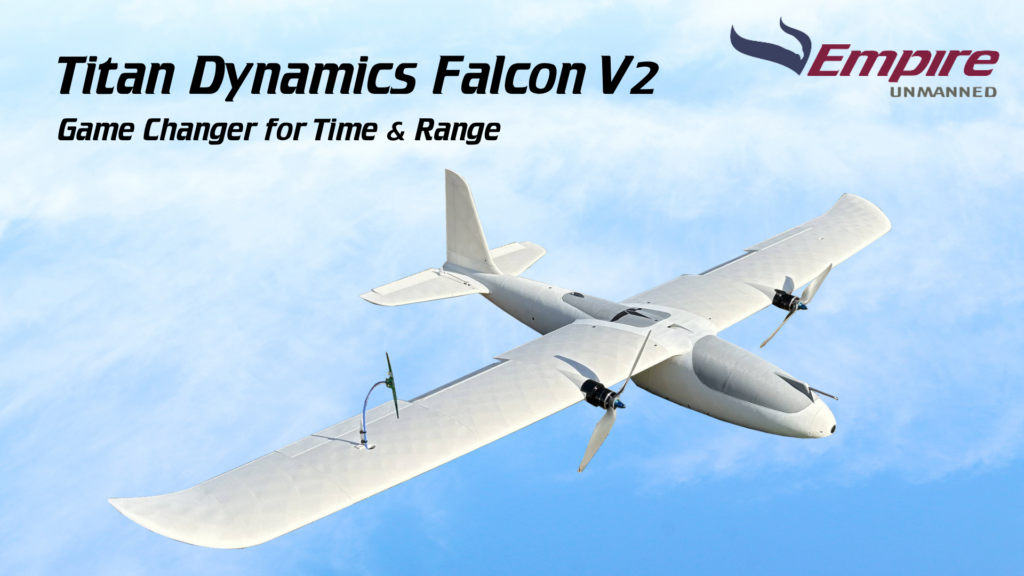Any relation to the land, the habit of tilling it, or mining it, or even hunting on it, generates the feeling of patriotism. He who keeps shop on it, or he who merely uses it as a support to his desk and ledger, or to his manufactory, values it less.
Miners are a special kind of people, and mining is a backbone of human progress and prosperity.
Which doesn’t mean that we have to keep doing things the same way!
The mining industry, known for navigating harsh environments and intricate operations, stands on the brink of a technological renaissance, largely driven by Unmanned Aerial Vehicles (UAVs). The integration of advanced drones like the Titan Dynamics Falcon V2 into mining operations heralds a new era of efficiency, safety, and environmental stewardship. The Falcon V2, with its impressive long-duration flight capability of up to five hours, is set to significantly augment various service niches within the sector.

Enhanced Data Collection and Analysis
One of the most significant future trends in mining drones is the advancement of data collection and analytical capabilities. Drones equipped with sophisticated sensors and imaging technologies can capture detailed aerial photographs and generate precise 3D models of mining sites. This data is invaluable for planning and monitoring purposes, allowing for a more detailed understanding of the geological environment. Future technological advancements are expected to enhance these capabilities further, enabling real-time data analysis and more accurate predictive models for mineral exploration and resource estimation.
Improved Safety and Risk Management
The safety of mine workers is a paramount concern in the mining industry. Drones play a crucial role in improving safety by providing aerial views of hazardous areas, thus minimizing the need for human presence in dangerous locations. In the future, drones are predicted to become even more integral to mine safety, equipped with advanced sensors to detect gas levels, structural instabilities, and other potential hazards. By providing early warnings and real-time surveillance, drones will significantly reduce the risk of accidents and improve overall safety conditions in mining operations.
Autonomous Drone Operations
While drones are currently operated manually or with limited autonomy, the future points toward fully autonomous drone operations. This evolution will allow for continuous, around-the-clock monitoring of mining sites without the need for human intervention. Autonomous drones will be able to navigate complex environments, conduct routine inspections, and even perform certain tasks, such as transporting samples or equipment. This shift will not only improve efficiency but also reduce operational costs and human exposure to hazardous mining environments.
Integration with Other Technologies
The integration of drones with other emerging technologies is a trend that is set to redefine the mining industry. In the future, drones will work alongside robotics, Artificial Intelligence (AI), and the Internet of Things (IoT) to create a more interconnected and automated mining ecosystem. For example, drones could feed real-time data into AI systems for immediate analysis, or work in tandem with ground-based robots for sample collection and material handling. This synergy between different technologies will enhance operational efficiencies, improve decision-making, and usher in a new era of smart mining.
Environmental Monitoring and Sustainability
As environmental concerns continue to rise, the mining industry is under increasing pressure to minimize its ecological footprint. Drones will play a crucial role in this effort by providing tools for environmental monitoring and compliance. Advanced sensors and imaging technology will allow drones to track changes in the environment, assess the impact of mining activities, and ensure compliance with environmental regulations. In the future, drones will be instrumental in promoting sustainable mining practices, from water management to reforestation efforts.
Regulatory Developments and Global Adoption
The use of drones in mining is subject to regulatory frameworks that vary across different regions and countries. As the benefits of drone technology become more apparent, it is anticipated that there will be a global move toward standardized regulations, facilitating the widespread adoption of drones in the mining industry. This regulatory evolution will not only ensure the safe and ethical use of drones but also enable mining companies worldwide to harness the full potential of this technology.
Customization and Specialization
The future of mining drones lies in customization and specialization. As the industry’s needs become more diverse, drones will be designed with specific mining applications in mind. This could include specialized drones for underground mapping, high-altitude mineral exploration, or underwater inspection. The ability to customize drones to suit particular tasks or environments will enhance their utility and effectiveness, making them an indispensable tool in the mining industry.
Conclusion
The future of drones in the mining industry is marked by technological advancements, increased safety measures, and a shift toward sustainability. As these trends continue to evolve, drones will become an even more integral part of mining operations, transforming traditional practices and setting new standards for efficiency and environmental responsibility. The predictive trends point toward a future where drones are not merely auxiliary tools but central components of the mining ecosystem, driving innovation and shaping the future of the industry. As we move forward, it is clear that the integration of drone technology will continue to revolutionize mining, making it safer, more efficient, and more sustainable.

